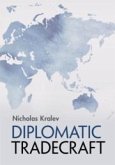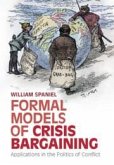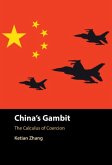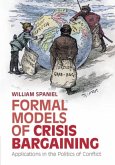James M. McCormick (Iowa State University)
American Foreign Policy and Process
James M. McCormick (Iowa State University)
American Foreign Policy and Process
- Broschiertes Buch
- Merkliste
- Auf die Merkliste
- Bewerten Bewerten
- Teilen
- Produkt teilen
- Produkterinnerung
- Produkterinnerung
A comprehensive analysis of the values and beliefs that have shaped American foreign policy, exploring how they have evolved over time. The author provides comparison of the changing policymaking approaches of administrations from Nixon through Biden in this new edition.
Andere Kunden interessierten sich auch für
![Race and Inequality in American Politics Race and Inequality in American Politics]() Zoltan L. Hajnal (San Diego University of California)Race and Inequality in American Politics45,99 €
Zoltan L. Hajnal (San Diego University of California)Race and Inequality in American Politics45,99 €![Diplomatic Tradecraft Diplomatic Tradecraft]() Diplomatic Tradecraft45,99 €
Diplomatic Tradecraft45,99 €![Formal Models of Crisis Bargaining Formal Models of Crisis Bargaining]() William Spaniel (University of Pittsburgh)Formal Models of Crisis Bargaining134,99 €
William Spaniel (University of Pittsburgh)Formal Models of Crisis Bargaining134,99 €![China's Gambit China's Gambit]() Ketian Zhang (Virginia George Mason University)China's Gambit99,99 €
Ketian Zhang (Virginia George Mason University)China's Gambit99,99 €![Formal Models of Crisis Bargaining Formal Models of Crisis Bargaining]() William Spaniel (University of Pittsburgh)Formal Models of Crisis Bargaining45,99 €
William Spaniel (University of Pittsburgh)Formal Models of Crisis Bargaining45,99 €![Civil War and Intrastate Armed Conflict Civil War and Intrastate Armed Conflict]() Karl DeRouen Jr. (The University of Alabama)Civil War and Intrastate Armed Conflict50,99 €
Karl DeRouen Jr. (The University of Alabama)Civil War and Intrastate Armed Conflict50,99 €![China's Gambit China's Gambit]() Ketian Zhang (Virginia George Mason University)China's Gambit33,99 €
Ketian Zhang (Virginia George Mason University)China's Gambit33,99 €-
-
-
A comprehensive analysis of the values and beliefs that have shaped American foreign policy, exploring how they have evolved over time. The author provides comparison of the changing policymaking approaches of administrations from Nixon through Biden in this new edition.
Produktdetails
- Produktdetails
- Verlag: Cambridge University Press
- 7 Revised edition
- Seitenzahl: 736
- Erscheinungstermin: 2. November 2023
- Englisch
- Abmessung: 254mm x 178mm x 37mm
- Gewicht: 1354g
- ISBN-13: 9781009278546
- ISBN-10: 1009278541
- Artikelnr.: 68537079
- Herstellerkennzeichnung
- Libri GmbH
- Europaallee 1
- 36244 Bad Hersfeld
- gpsr@libri.de
- Verlag: Cambridge University Press
- 7 Revised edition
- Seitenzahl: 736
- Erscheinungstermin: 2. November 2023
- Englisch
- Abmessung: 254mm x 178mm x 37mm
- Gewicht: 1354g
- ISBN-13: 9781009278546
- ISBN-10: 1009278541
- Artikelnr.: 68537079
- Herstellerkennzeichnung
- Libri GmbH
- Europaallee 1
- 36244 Bad Hersfeld
- gpsr@libri.de
James M. McCormick, Professor Emeritus of Political Science, taught at Iowa State University for over four decades. He has published American Foreign Policy and Process (six editions), co-edited The Domestic Sources of American Foreign Policy (seven editions), and has had articles published in World Politics, American Political Science Review, American Journal of Political Science, and many more. He has been the recipient of numerous academic awards, including the ISU Foundation Award for Outstanding Research, Fulbright Senior Award, and the ISU International Service Award.
List of figures
List of maps
List of tables
Documents and document summaries
__ Preface
Part I. Values and Policies in American Foreign Affairs
1. America's traditions in foreign policy
2. America's global involvement and the emergence of the Cold War
3. After the missile crisis and the Vietnam War: realism and liberalism in foreign policy
4. The return and end of the Cold War: the Reagan and Bush administrations
5. Foreign policy after the Cold War and 9/11: the Clinton and Bush administrations
6. Changing foreign policy directions: the Obama and Trump administrations
7. A foreign policy of restoration? The Biden administration
Part II. The Process of Policy Making
8. The President and the making of foreign policy
9. Congressional prerogatives and the making of foreign policy
10. The diplomatic and economic bureaucracies: duplication or specialization?
11. The military and intelligence bureaucracies: pervasive or accountable?
12. Political parties, bipartisanship, and interest groups
13. The media, public opinion, and the foreign policy process
Part III. Conclusion
14. American foreign policy values and the future
Index
List of maps
List of tables
Documents and document summaries
__ Preface
Part I. Values and Policies in American Foreign Affairs
1. America's traditions in foreign policy
2. America's global involvement and the emergence of the Cold War
3. After the missile crisis and the Vietnam War: realism and liberalism in foreign policy
4. The return and end of the Cold War: the Reagan and Bush administrations
5. Foreign policy after the Cold War and 9/11: the Clinton and Bush administrations
6. Changing foreign policy directions: the Obama and Trump administrations
7. A foreign policy of restoration? The Biden administration
Part II. The Process of Policy Making
8. The President and the making of foreign policy
9. Congressional prerogatives and the making of foreign policy
10. The diplomatic and economic bureaucracies: duplication or specialization?
11. The military and intelligence bureaucracies: pervasive or accountable?
12. Political parties, bipartisanship, and interest groups
13. The media, public opinion, and the foreign policy process
Part III. Conclusion
14. American foreign policy values and the future
Index
List of figures
List of maps
List of tables
Documents and document summaries
__ Preface
Part I. Values and Policies in American Foreign Affairs
1. America's traditions in foreign policy
2. America's global involvement and the emergence of the Cold War
3. After the missile crisis and the Vietnam War: realism and liberalism in foreign policy
4. The return and end of the Cold War: the Reagan and Bush administrations
5. Foreign policy after the Cold War and 9/11: the Clinton and Bush administrations
6. Changing foreign policy directions: the Obama and Trump administrations
7. A foreign policy of restoration? The Biden administration
Part II. The Process of Policy Making
8. The President and the making of foreign policy
9. Congressional prerogatives and the making of foreign policy
10. The diplomatic and economic bureaucracies: duplication or specialization?
11. The military and intelligence bureaucracies: pervasive or accountable?
12. Political parties, bipartisanship, and interest groups
13. The media, public opinion, and the foreign policy process
Part III. Conclusion
14. American foreign policy values and the future
Index
List of maps
List of tables
Documents and document summaries
__ Preface
Part I. Values and Policies in American Foreign Affairs
1. America's traditions in foreign policy
2. America's global involvement and the emergence of the Cold War
3. After the missile crisis and the Vietnam War: realism and liberalism in foreign policy
4. The return and end of the Cold War: the Reagan and Bush administrations
5. Foreign policy after the Cold War and 9/11: the Clinton and Bush administrations
6. Changing foreign policy directions: the Obama and Trump administrations
7. A foreign policy of restoration? The Biden administration
Part II. The Process of Policy Making
8. The President and the making of foreign policy
9. Congressional prerogatives and the making of foreign policy
10. The diplomatic and economic bureaucracies: duplication or specialization?
11. The military and intelligence bureaucracies: pervasive or accountable?
12. Political parties, bipartisanship, and interest groups
13. The media, public opinion, and the foreign policy process
Part III. Conclusion
14. American foreign policy values and the future
Index









